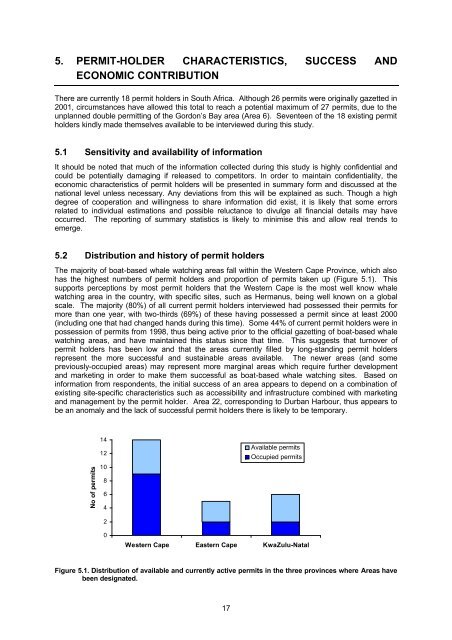Download PDF (2.5MB) - Anchor Environmental
Download PDF (2.5MB) - Anchor Environmental
Download PDF (2.5MB) - Anchor Environmental
You also want an ePaper? Increase the reach of your titles
YUMPU automatically turns print PDFs into web optimized ePapers that Google loves.
5. PERMIT-HOLDER CHARACTERISTICS, SUCCESS AND<br />
ECONOMIC CONTRIBUTION<br />
There are currently 18 permit holders in South Africa. Although 26 permits were originally gazetted in<br />
2001, circumstances have allowed this total to reach a potential maximum of 27 permits, due to the<br />
unplanned double permitting of the Gordon’s Bay area (Area 6). Seventeen of the 18 existing permit<br />
holders kindly made themselves available to be interviewed during this study.<br />
5.1 Sensitivity and availability of information<br />
It should be noted that much of the information collected during this study is highly confidential and<br />
could be potentially damaging if released to competitors. In order to maintain confidentiality, the<br />
economic characteristics of permit holders will be presented in summary form and discussed at the<br />
national level unless necessary. Any deviations from this will be explained as such. Though a high<br />
degree of cooperation and willingness to share information did exist, it is likely that some errors<br />
related to individual estimations and possible reluctance to divulge all financial details may have<br />
occurred. The reporting of summary statistics is likely to minimise this and allow real trends to<br />
emerge.<br />
5.2 Distribution and history of permit holders<br />
The majority of boat-based whale watching areas fall within the Western Cape Province, which also<br />
has the highest numbers of permit holders and proportion of permits taken up (Figure 5.1). This<br />
supports perceptions by most permit holders that the Western Cape is the most well know whale<br />
watching area in the country, with specific sites, such as Hermanus, being well known on a global<br />
scale. The majority (80%) of all current permit holders interviewed had possessed their permits for<br />
more than one year, with two-thirds (69%) of these having possessed a permit since at least 2000<br />
(including one that had changed hands during this time). Some 44% of current permit holders were in<br />
possession of permits from 1998, thus being active prior to the official gazetting of boat-based whale<br />
watching areas, and have maintained this status since that time. This suggests that turnover of<br />
permit holders has been low and that the areas currently filled by long-standing permit holders<br />
represent the more successful and sustainable areas available. The newer areas (and some<br />
previously-occupied areas) may represent more marginal areas which require further development<br />
and marketing in order to make them successful as boat-based whale watching sites. Based on<br />
information from respondents, the initial success of an area appears to depend on a combination of<br />
existing site-specific characteristics such as accessibility and infrastructure combined with marketing<br />
and management by the permit holder. Area 22, corresponding to Durban Harbour, thus appears to<br />
be an anomaly and the lack of successful permit holders there is likely to be temporary.<br />
No of permits<br />
14<br />
12<br />
10<br />
8<br />
6<br />
4<br />
2<br />
0<br />
Available permits<br />
Occupied permits<br />
Western Cape Eastern Cape KwaZulu-Natal<br />
Figure 5.1. Distribution of available and currently active permits in the three provinces where Areas have<br />
been designated.<br />
17
















